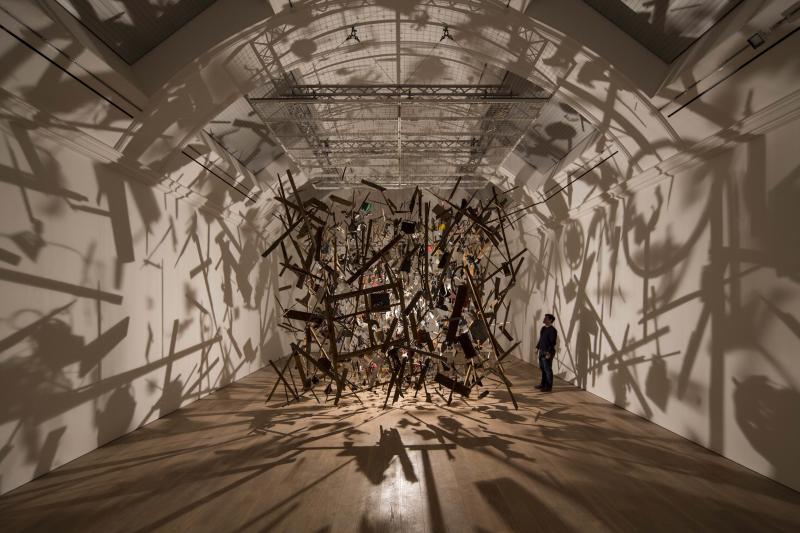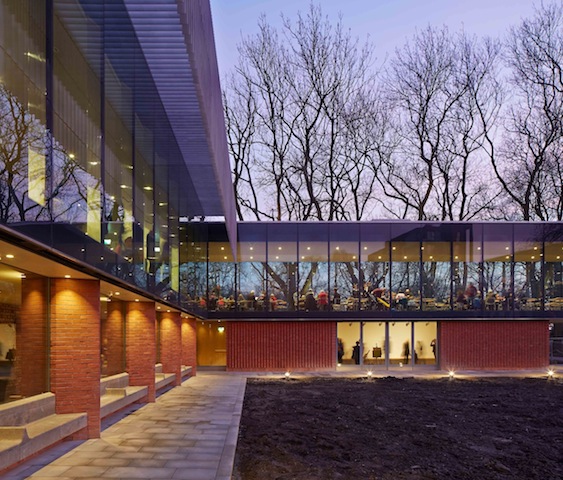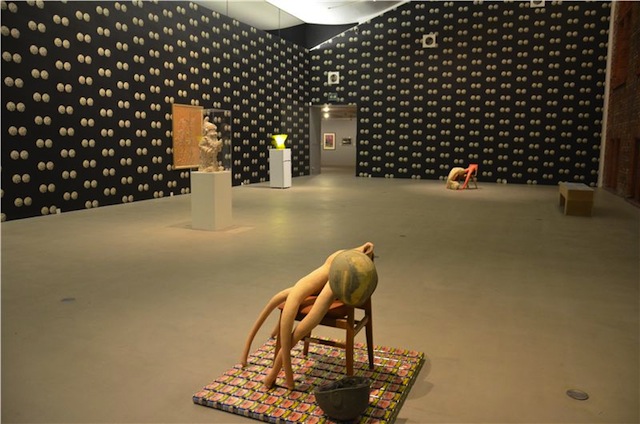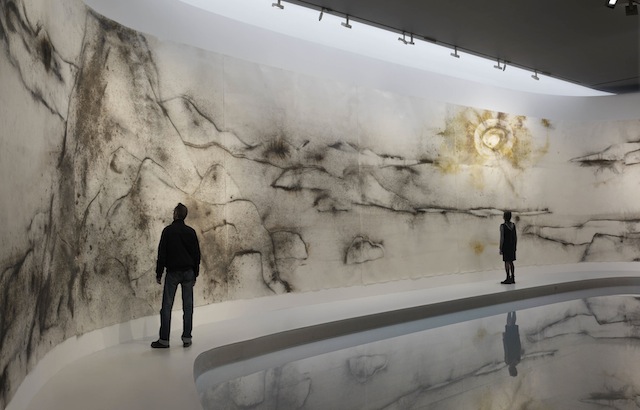Whitworth Art Gallery Reopens with a Meteoric Bang | reviews, news & interviews
Whitworth Art Gallery Reopens with a Meteoric Bang
Whitworth Art Gallery Reopens with a Meteoric Bang
The Manchester gallery celebrates its past and looks to its future

The Whitworth Art Gallery was showered with meteors in a spectacle devised by the artist Cornelia Parker on its reopening weekend – appropriately Valentine’s Day. The £15m project (architects MUMA) has doubled the exhibition spaces, reclaimed the Victorian Grand Hall from offices, added state-of-the-art on-site storage and more space for conservators.
Here is public art with sculpture and installations on the building itself, and in the surrounding park – landscape art not only in its park setting but within new gardens, and with the building providing wrap-around scenic views. There are two elegantly redesigned shops and access is emphasised: there is now a huge study centre, with handling sessions promised, as well as the opportunity to call out stored objects for perusal. Henry Cole’s maxim for the founding of the Victoria & Albert Museum, that the body has to be fed as well as the spirit, is exemplified by a quietly exuberant glass-walled café, on the raised ground floor and thus almost at tree level.
The gallery was opened in 1889 for the gratification of Mancunians, as its founders put it. Named after a Cheshire-born industrialist, engineer and philanthropist, it embraces both fine and decorative arts and is the perfect example of Victorian philanthropy: art not only for its own sake, but also for enlightened pedagogical purposes. The ruling classes believed in the morally improving power of art – or at least in distracting the masses.
 The Whitworth became part of the University of Manchester in 1958, and so it is also a teaching gallery, part of the art history and museological study programme of England’s largest university, with an internationally significant collection, numerically modest compared to – say – our great national museums but high in quality: 55,000 catalogued objects so far.
The Whitworth became part of the University of Manchester in 1958, and so it is also a teaching gallery, part of the art history and museological study programme of England’s largest university, with an internationally significant collection, numerically modest compared to – say – our great national museums but high in quality: 55,000 catalogued objects so far.
The historic and contemporary collections of wallpaper, textiles, fashion, British watercolours, international works on paper and outsider art, are the kind of magpie mix that means curators have lots to play with in terms of telling different stories, from social history to art history. And visiting artists can play too: the Sarah Lucas exhibition is peculiarly tasteful as well as eerie. The big first-floor gallery is given over to several weird stuffed dolls, leaning at weird angles, oddly poignant, and the walls are covered in Sarah Lucas wallpaper: paired images of balls made out of half-smoked cigarettes, recalling her obsessions with the female breast. It’s titled Tits in Space (installation pictured below).
 On the ground floor four galleries are given over to new and old installations and wall hanging works by Cornelia Parker. Cold Dark Matter: An Exploded View, 1991 (main picture), the result of Parker persuading British army explosive experts to blow up a garden shed, remains as dramatically captivating as ever in a darkened gallery all to itself, its exploded quotidian self casting mysterious shadows, a benign disaster. This mesmerising installation shows us how Parker can transform the ordinary. The fragments, no longer useful or practical, are curiously made whole as an arbitrary yet thought-through work of art.
On the ground floor four galleries are given over to new and old installations and wall hanging works by Cornelia Parker. Cold Dark Matter: An Exploded View, 1991 (main picture), the result of Parker persuading British army explosive experts to blow up a garden shed, remains as dramatically captivating as ever in a darkened gallery all to itself, its exploded quotidian self casting mysterious shadows, a benign disaster. This mesmerising installation shows us how Parker can transform the ordinary. The fragments, no longer useful or practical, are curiously made whole as an arbitrary yet thought-through work of art.
Parker highlights the discarded and the disregarded elsewhere: there are floor-hugging metal sculptures which are casts of the cracks in sidewalks and pavements. One large gallery has its walls and ceiling covered – the roof tent-like – with the offcuts from the factory that makes the Royal British Legion poppies we bought – 45 million of them – in the autumn leading up to Remembrance Day. The installation is called War Room, oddly innocent and decorative, peculiarly suggestive of the conflicted emotions of commemoration, pride, celebration and horror that surround and even obscure the hideous realities of warfare.
Posed against the views of surrounding park, Parker has wrapped the entwined marble figures of Rodin’s The Kiss with a mile of string, calling her intervention The Distance (A Kiss with String Attached).
Elsewhere, Turner, Blake, Girtin and Constable and a host of others are exhibited in a dense hang of watercolours in three installations. A gallery of portraits offers an attractively bewildering mash-up of styles, and includes Bacon’s evocation of Lucian Freud, Otto Dix and Eduardo Paolozzi. One wall of portraits of various benefactors, collectors and artists tells the history of the Whitworth in visual terms, while a further gallery focuses on British art of the 1960s.
 In the Landscape Gallery, again looking out on to the park, there is a magnificent installation of a huge wrap-around landscape, Chinese in feel, although made by that magician of ephemeral explosions – including the opening and closing of the Beijing Olympics – the Japanese artist Cai Guo-Qiang. Unmanned Nature (pictured above) was commissioned in 2008 by the city of Hiroshima, and its meandering lines suggest an evocative landscape of rolling hills; blackened, softly wandering contours overseen by a blazing sun, were made by burning gunpowder onto a paper surface. The drawings, altogether 12 foot high and 126 foot long, surround a reflective pool.
In the Landscape Gallery, again looking out on to the park, there is a magnificent installation of a huge wrap-around landscape, Chinese in feel, although made by that magician of ephemeral explosions – including the opening and closing of the Beijing Olympics – the Japanese artist Cai Guo-Qiang. Unmanned Nature (pictured above) was commissioned in 2008 by the city of Hiroshima, and its meandering lines suggest an evocative landscape of rolling hills; blackened, softly wandering contours overseen by a blazing sun, were made by burning gunpowder onto a paper surface. The drawings, altogether 12 foot high and 126 foot long, surround a reflective pool.
The galleries do not provide the kind of straight chronological walk-through that is so often the usual display: rather there are lots of different stories and byways. Nothing is taken for granted. The large rooms and wide corridors bathe the visitor in natural light. The unexpected juxtapositions of the different galleries and varied collections encourage unforced speculations on the astonishingly different things people make. In various glimpses into the permanent collection both stylistic unity and coherent chronology are abandoned as organising principles, while the single artist exhibitions suggest both individual style and coherence. The renewed Whitworth is an exciting place to be.
Explore topics
Share this article
The future of Arts Journalism
You can stop theartsdesk.com closing!
We urgently need financing to survive. Our fundraising drive has thus far raised £49,000 but we need to reach £100,000 or we will be forced to close. Please contribute here: https://gofund.me/c3f6033d
And if you can forward this information to anyone who might assist, we’d be grateful.

Subscribe to theartsdesk.com
Thank you for continuing to read our work on theartsdesk.com. For unlimited access to every article in its entirety, including our archive of more than 15,000 pieces, we're asking for £5 per month or £40 per year. We feel it's a very good deal, and hope you do too.
To take a subscription now simply click here.
And if you're looking for that extra gift for a friend or family member, why not treat them to a theartsdesk.com gift subscription?
more Visual arts
 'We are bowled over!' Thank you for your messages of love and support
Much-appreciated words of commendation from readers and the cultural community
'We are bowled over!' Thank you for your messages of love and support
Much-appreciated words of commendation from readers and the cultural community
 Photo Oxford 2025 review - photography all over the town
At last, a UK festival that takes photography seriously
Photo Oxford 2025 review - photography all over the town
At last, a UK festival that takes photography seriously
![SEX MONEY RACE RELIGION [2016] by Gilbert and George. Installation shot of Gilbert & George 21ST CENTURY PICTURES Hayward Gallery](https://theartsdesk.com/sites/default/files/styles/thumbnail/public/mastimages/Gilbert%20%26%20George_%2021ST%20CENTURY%20PICTURES.%20SEX%20MONEY%20RACE%20RELIGION%20%5B2016%5D.%20Photo_%20Mark%20Blower.%20Courtesy%20of%20the%20Gilbert%20%26%20George%20and%20the%20Hayward%20Gallery._0.jpg?itok=7tVsLyR-) Gilbert & George, 21st Century Pictures, Hayward Gallery review - brash, bright and not so beautiful
The couple's coloured photomontages shout louder than ever, causing sensory overload
Gilbert & George, 21st Century Pictures, Hayward Gallery review - brash, bright and not so beautiful
The couple's coloured photomontages shout louder than ever, causing sensory overload
 Lee Miller, Tate Britain review - an extraordinary career that remains an enigma
Fashion photographer, artist or war reporter; will the real Lee Miller please step forward?
Lee Miller, Tate Britain review - an extraordinary career that remains an enigma
Fashion photographer, artist or war reporter; will the real Lee Miller please step forward?
 Kerry James Marshall: The Histories, Royal Academy review - a triumphant celebration of blackness
Room after room of glorious paintings
Kerry James Marshall: The Histories, Royal Academy review - a triumphant celebration of blackness
Room after room of glorious paintings
 Folkestone Triennial 2025 - landscape, seascape, art lovers' escape
Locally rooted festival brings home many but not all global concerns
Folkestone Triennial 2025 - landscape, seascape, art lovers' escape
Locally rooted festival brings home many but not all global concerns
 Sir Brian Clarke (1953-2025) - a personal tribute
Remembering an artist with a gift for the transcendent
Sir Brian Clarke (1953-2025) - a personal tribute
Remembering an artist with a gift for the transcendent
 Emily Kam Kngwarray, Tate Modern review - glimpses of another world
Pictures that are an affirmation of belonging
Emily Kam Kngwarray, Tate Modern review - glimpses of another world
Pictures that are an affirmation of belonging
 Kiefer / Van Gogh, Royal Academy review - a pairing of opposites
Small scale intensity meets large scale melodrama
Kiefer / Van Gogh, Royal Academy review - a pairing of opposites
Small scale intensity meets large scale melodrama
 Jenny Saville: The Anatomy of Painting, National Portrait Gallery review - a protégé losing her way
A brilliant painter in search of a worthwhile subject
Jenny Saville: The Anatomy of Painting, National Portrait Gallery review - a protégé losing her way
A brilliant painter in search of a worthwhile subject
 Abstract Erotic, Courtauld Gallery review - sculpture that is sensuous, funny and subversive
Testing the boundaries of good taste, and winning
Abstract Erotic, Courtauld Gallery review - sculpture that is sensuous, funny and subversive
Testing the boundaries of good taste, and winning
 Edward Burra, Tate Britain review - watercolour made mainstream
Social satire with a nasty bite
Edward Burra, Tate Britain review - watercolour made mainstream
Social satire with a nasty bite

Add comment